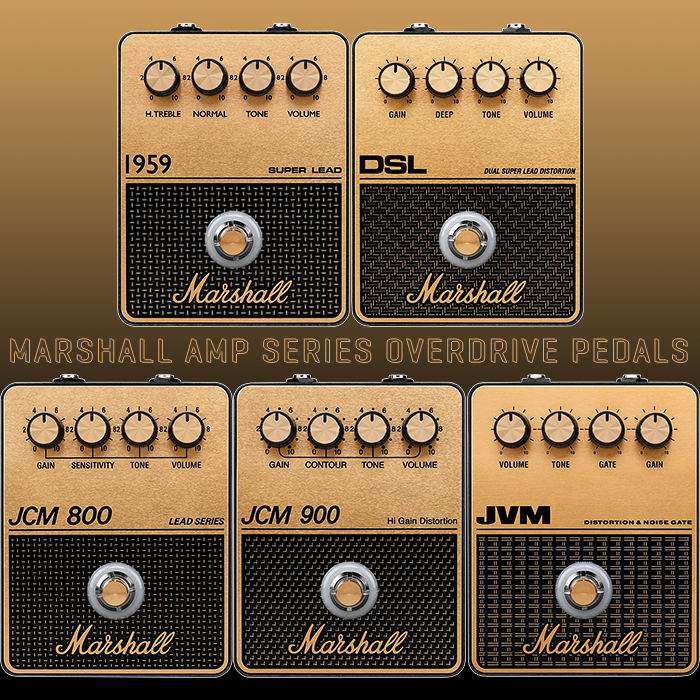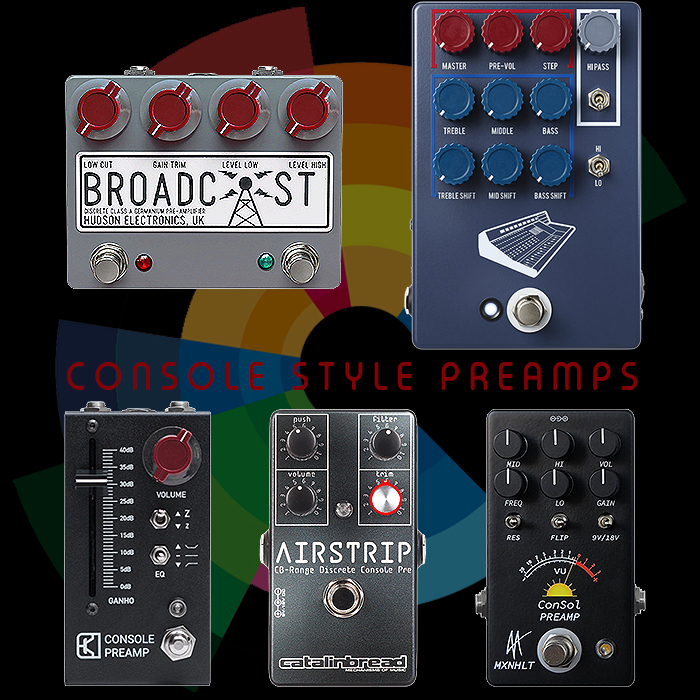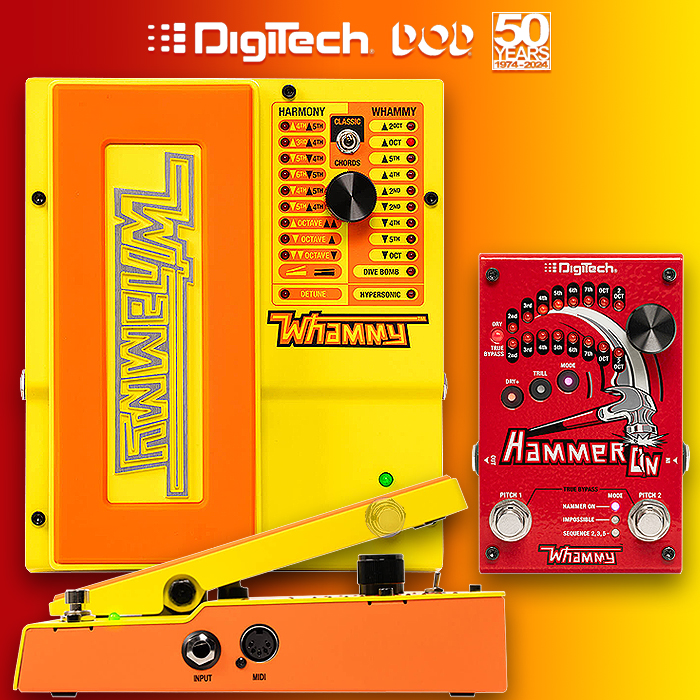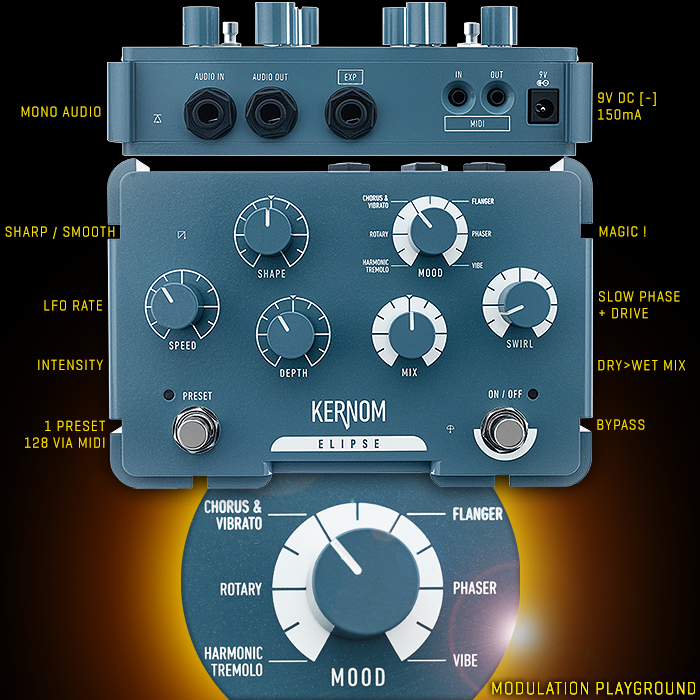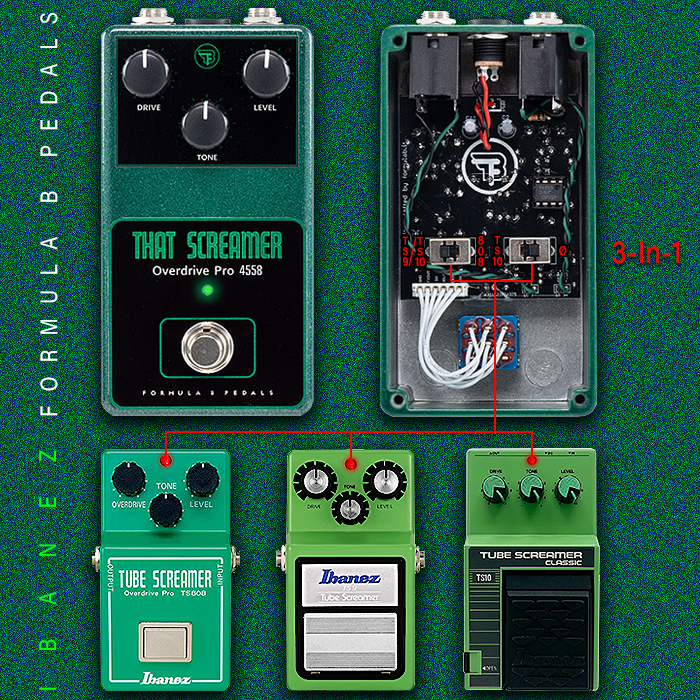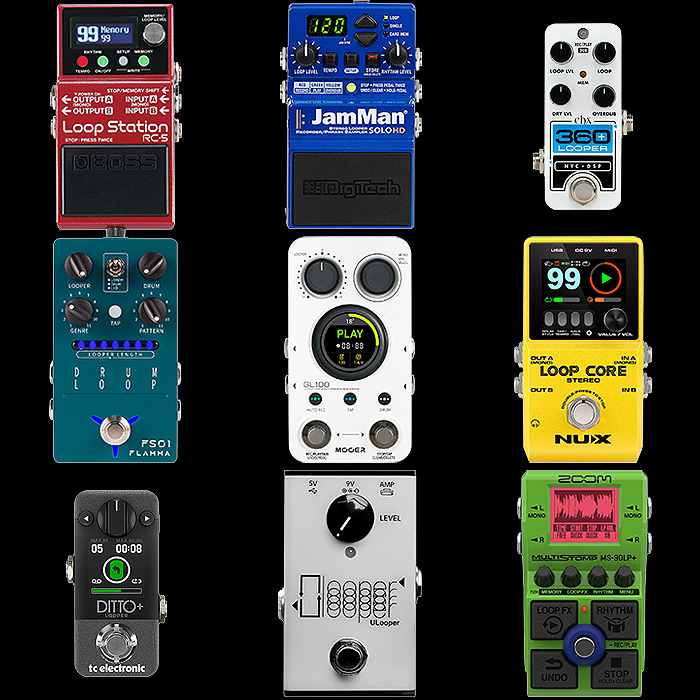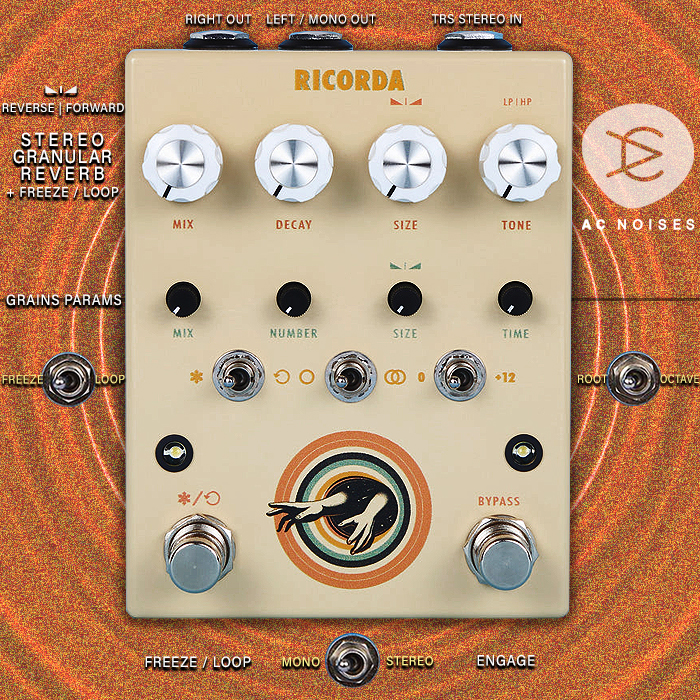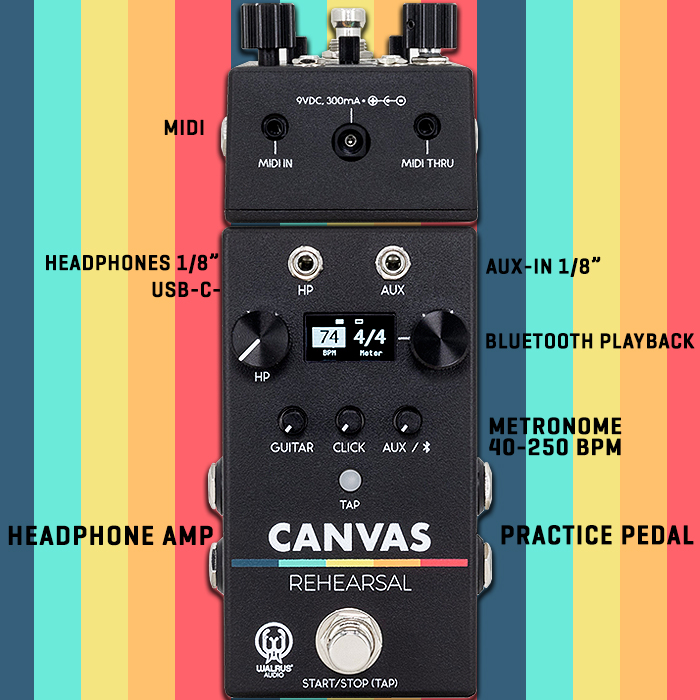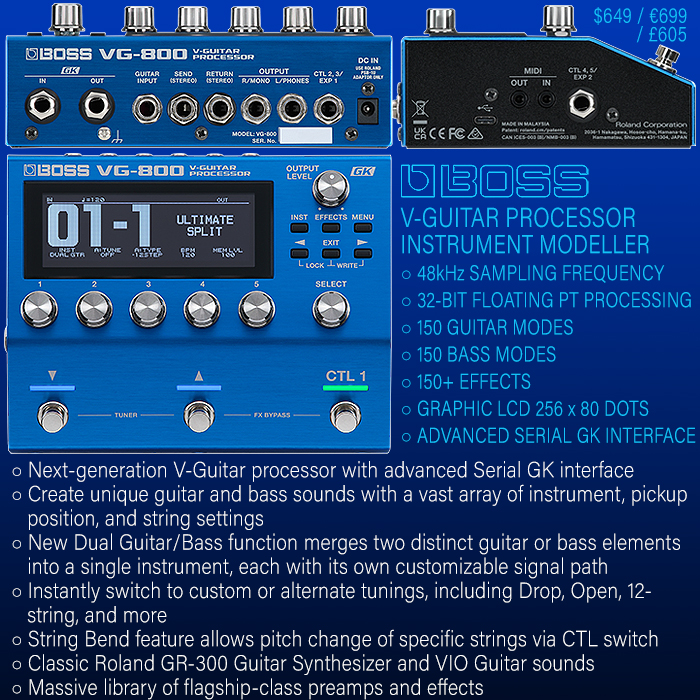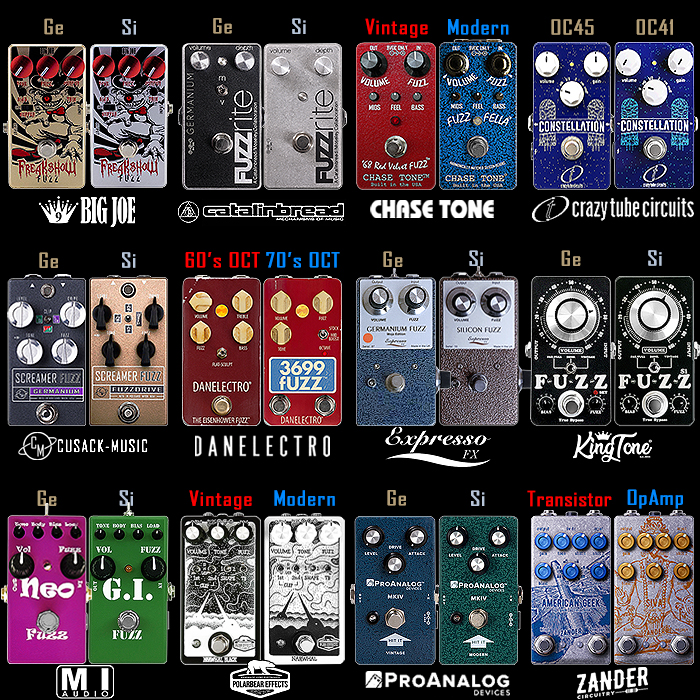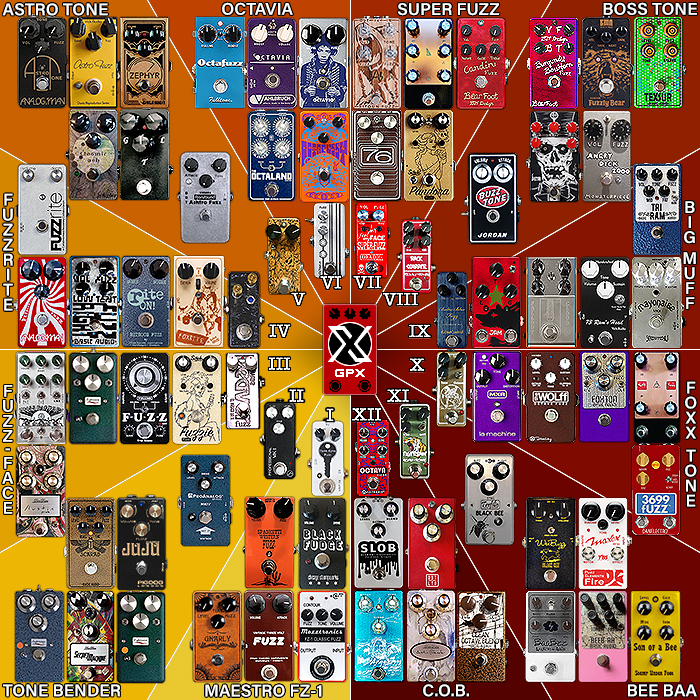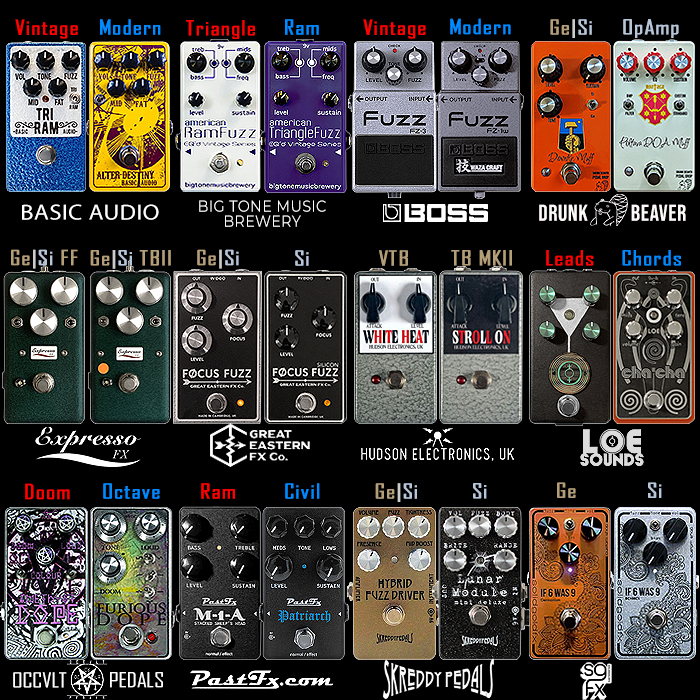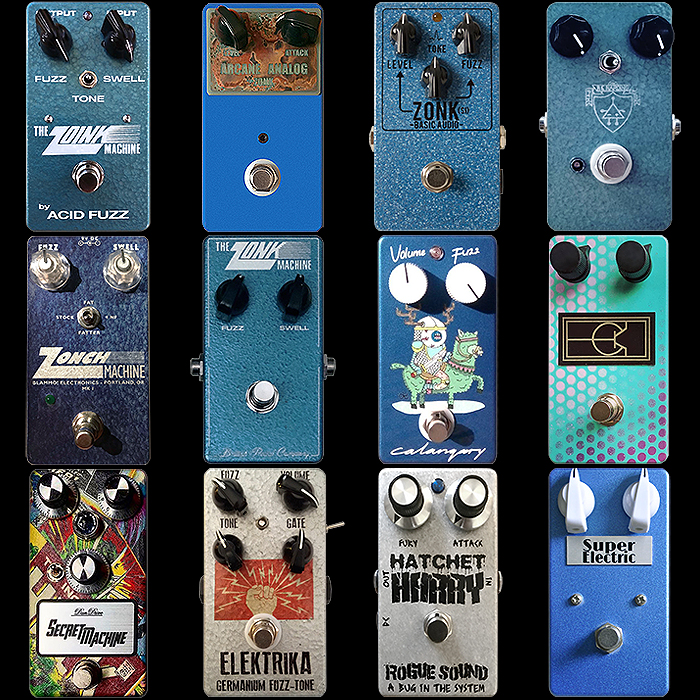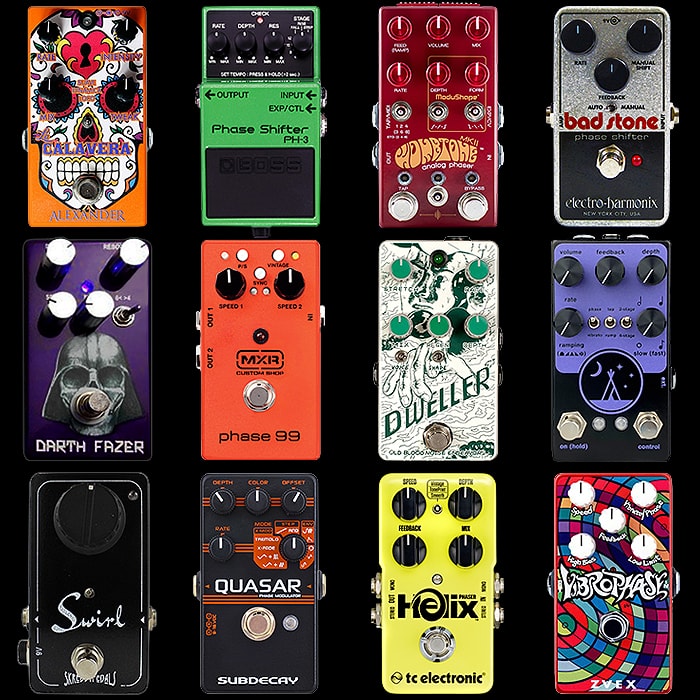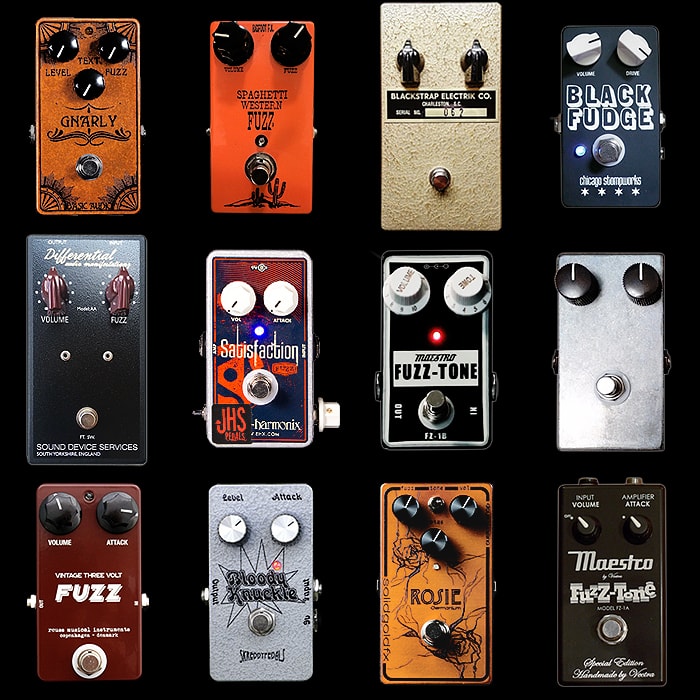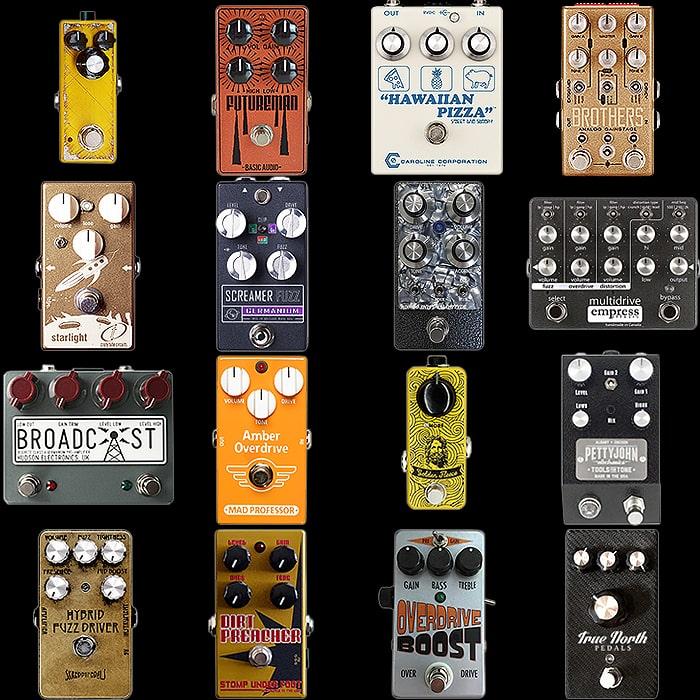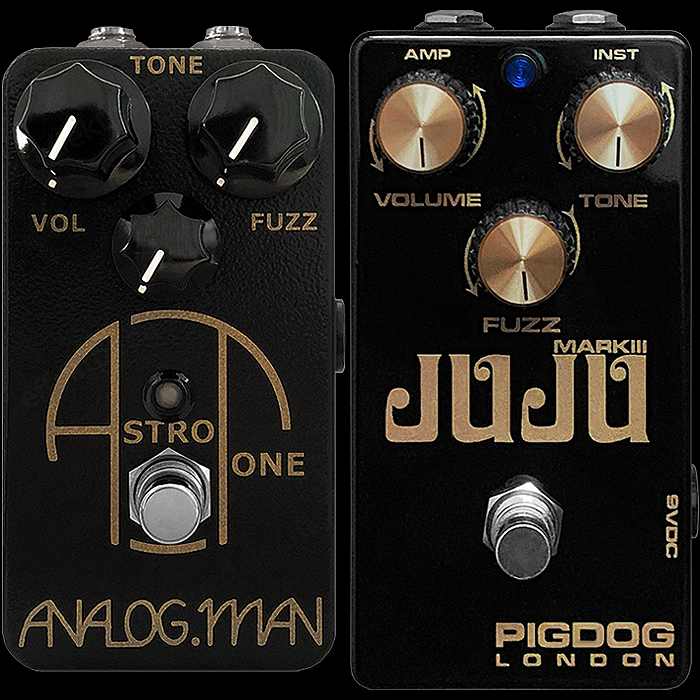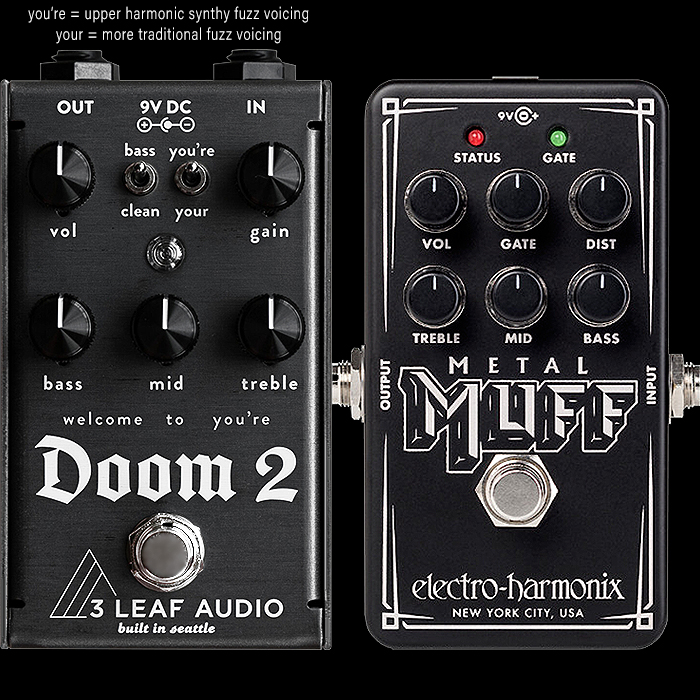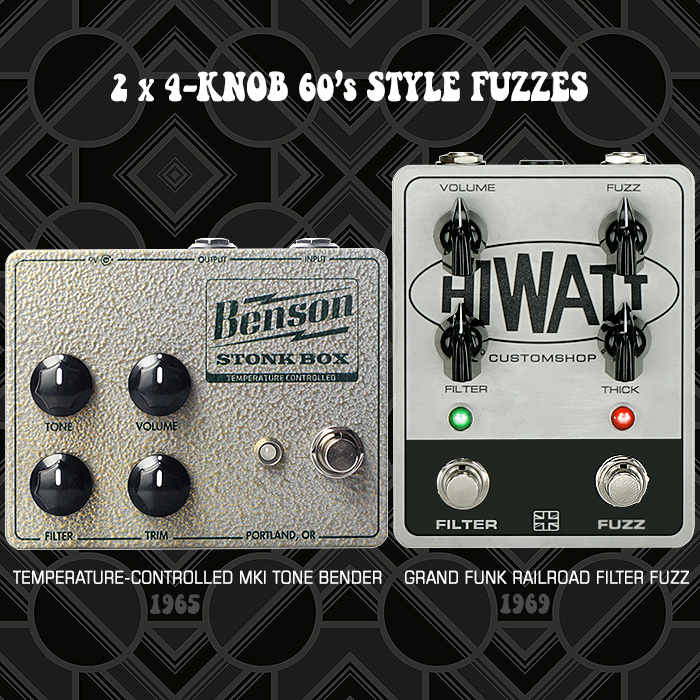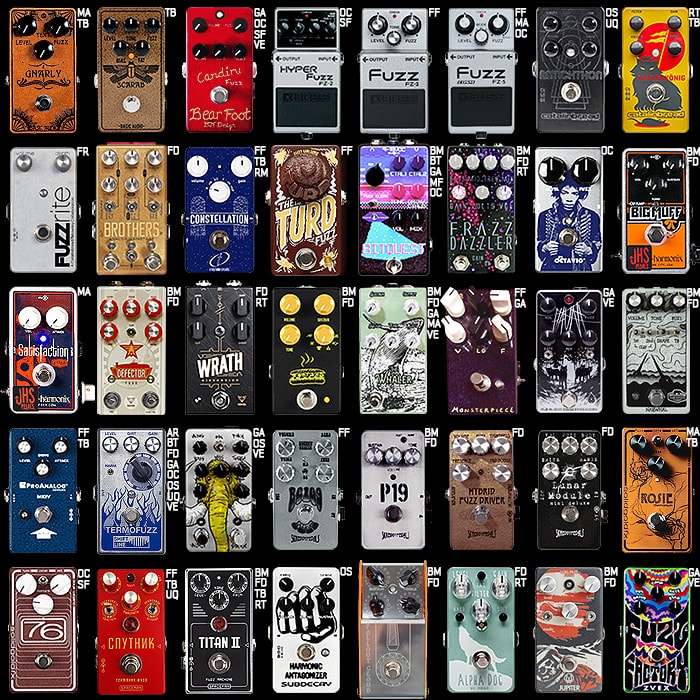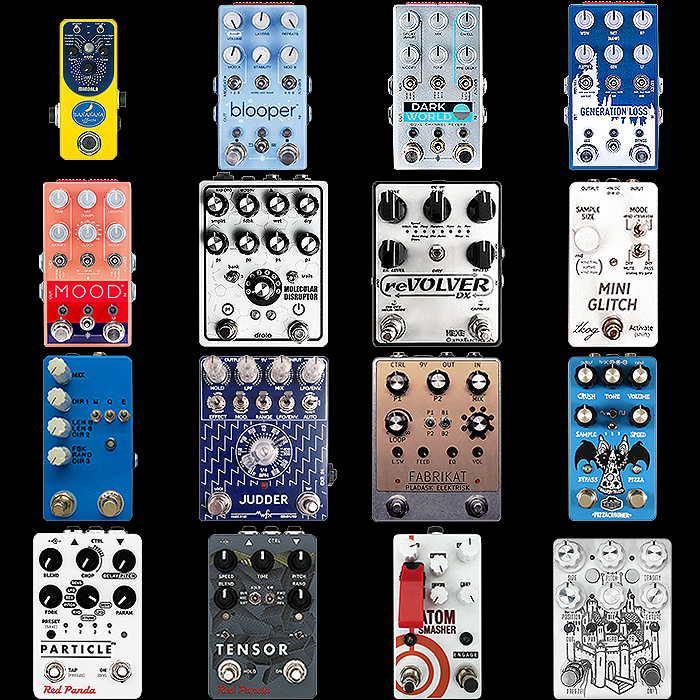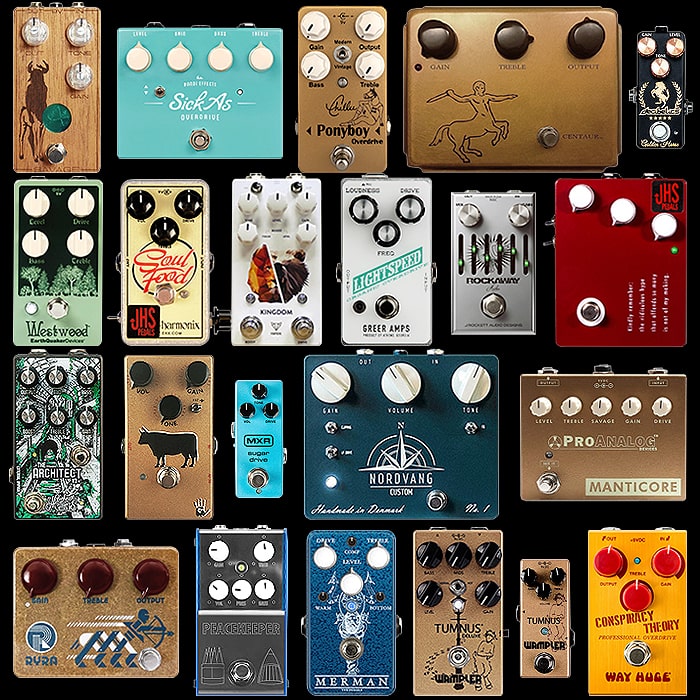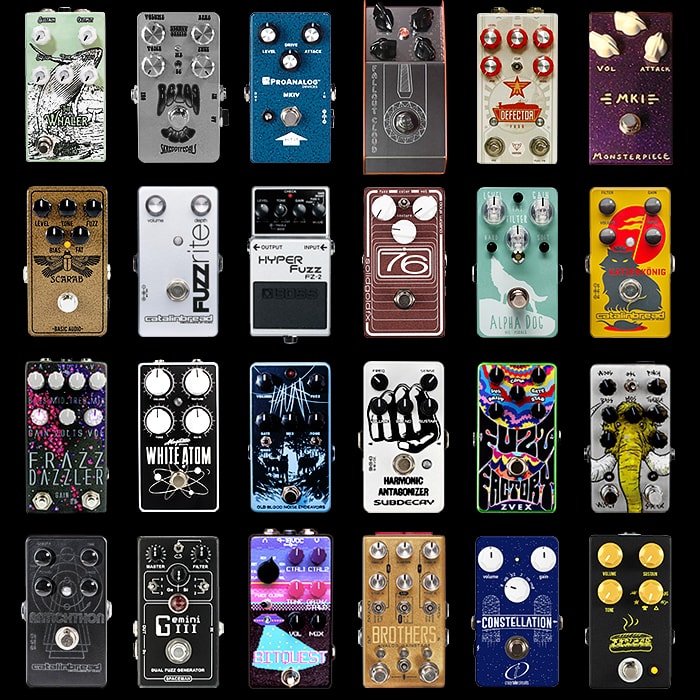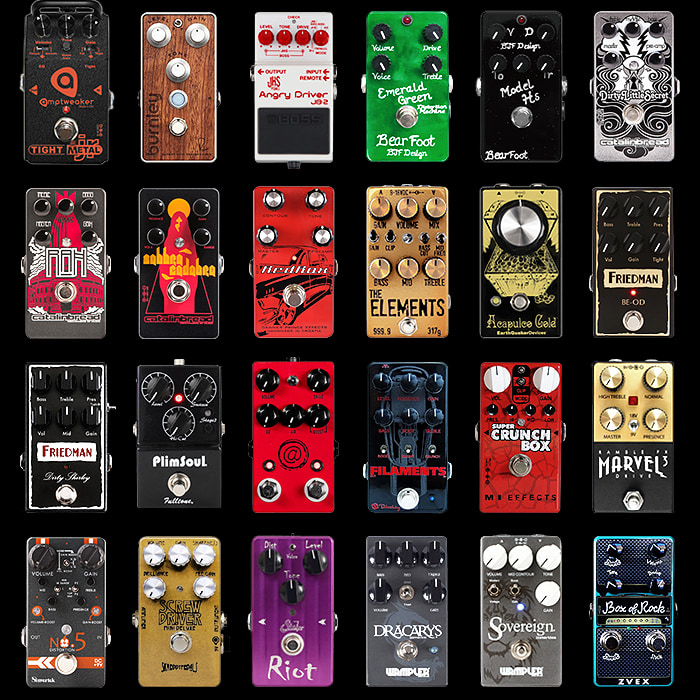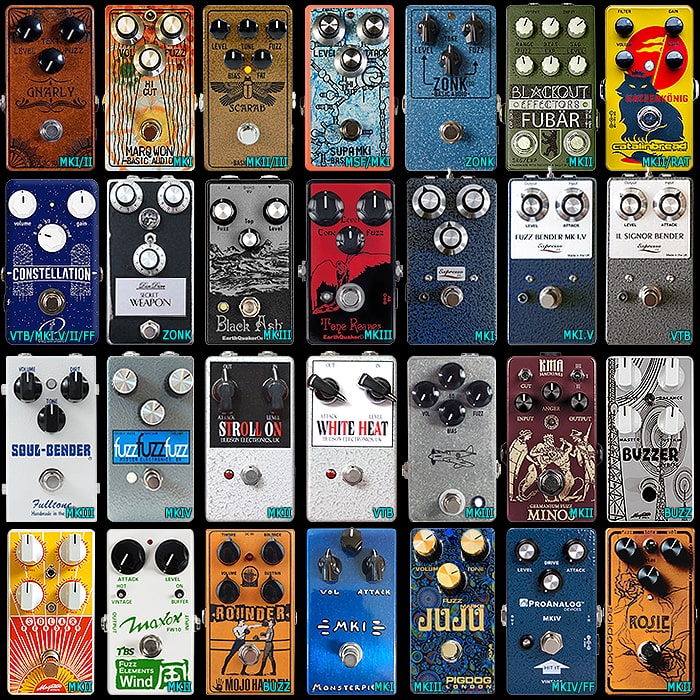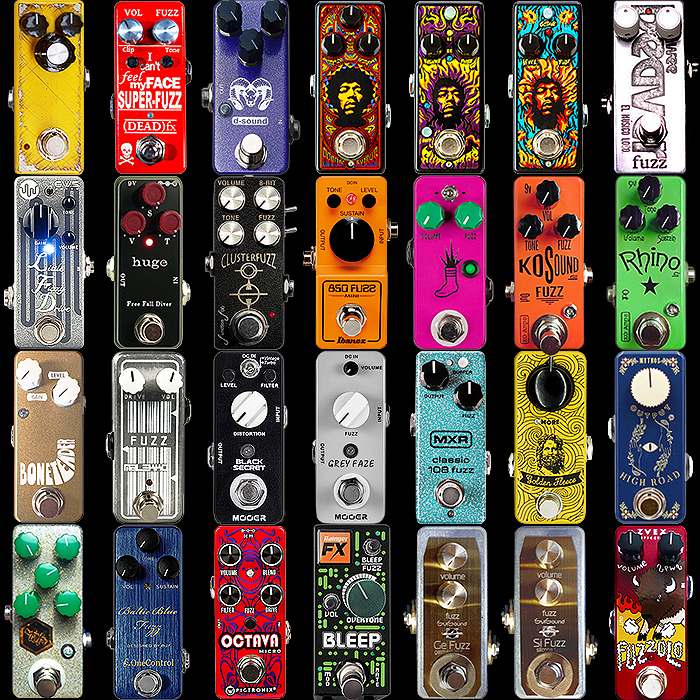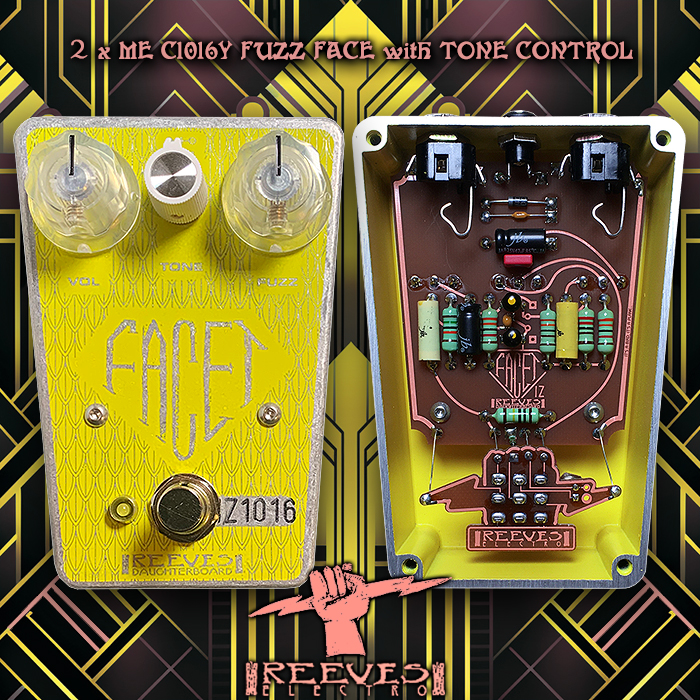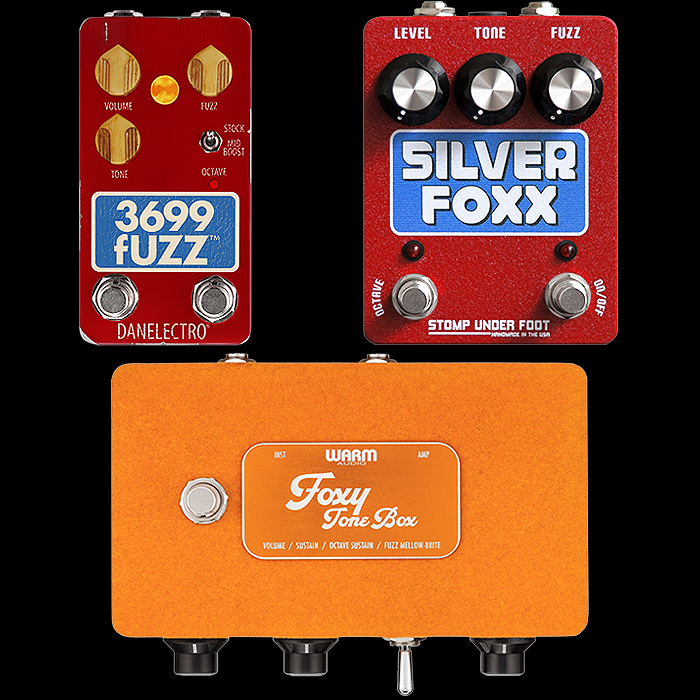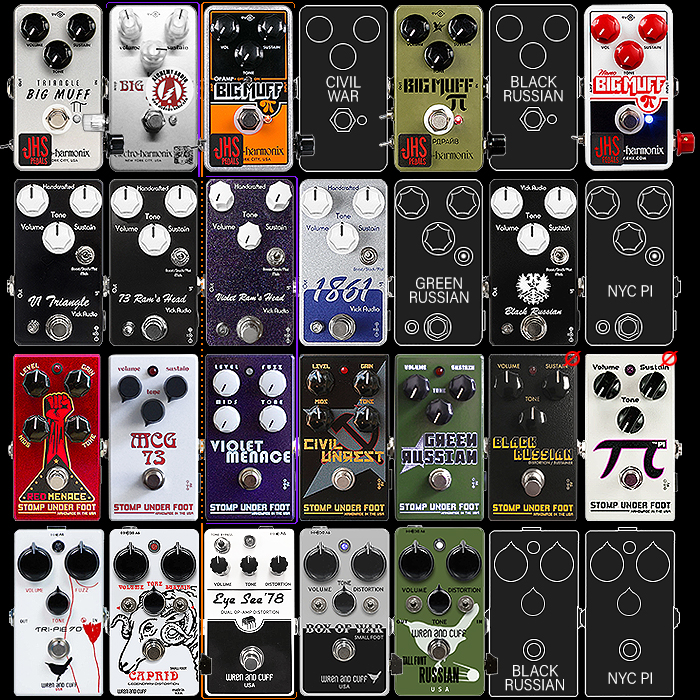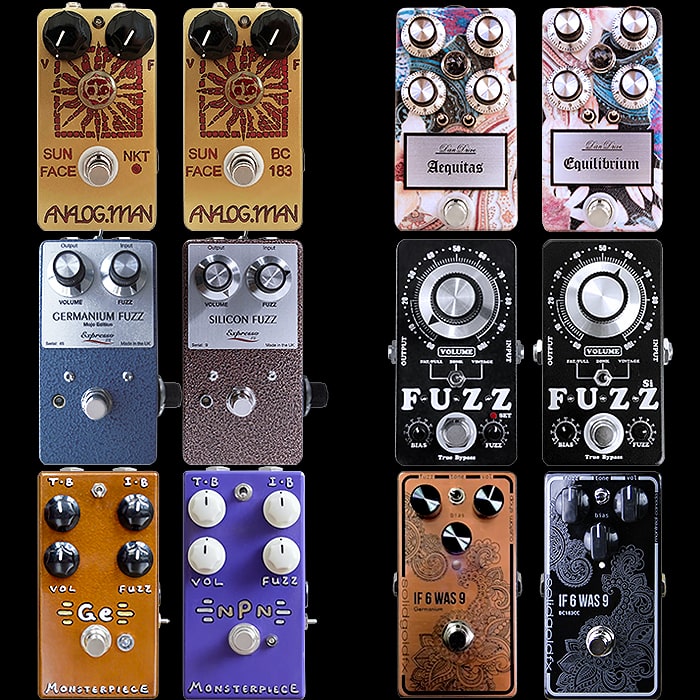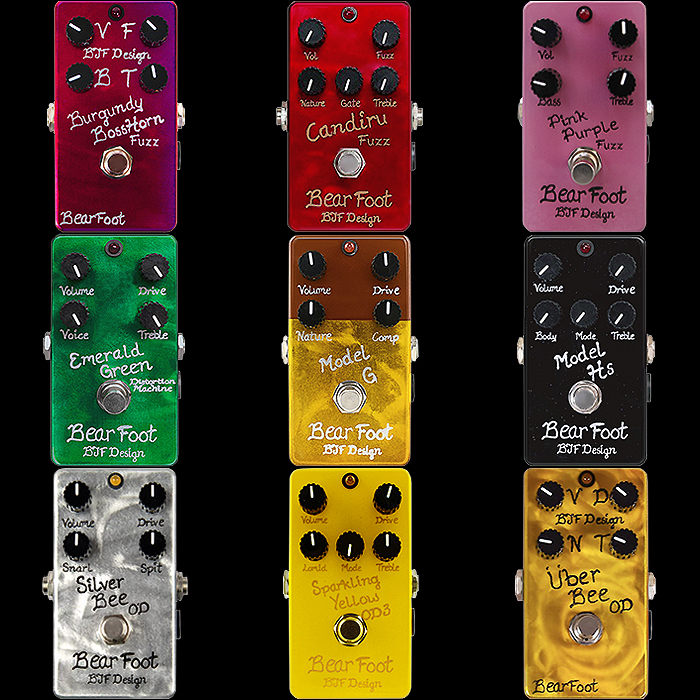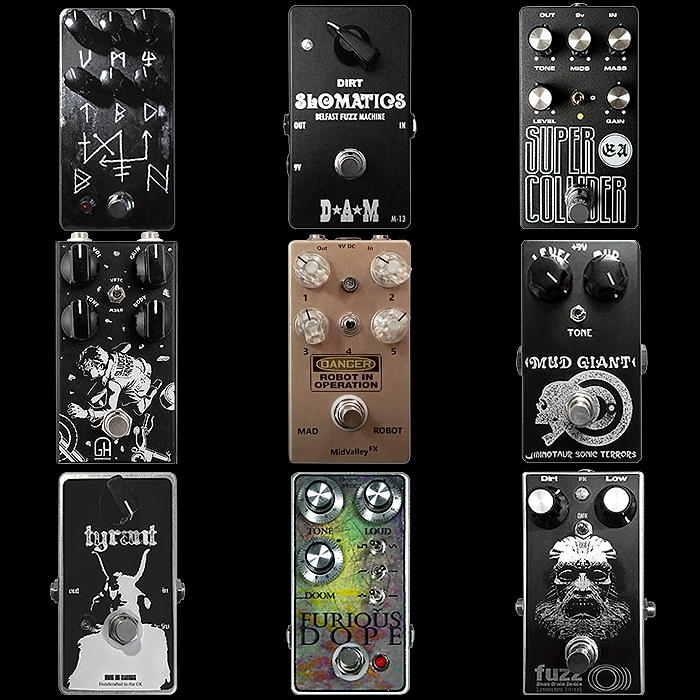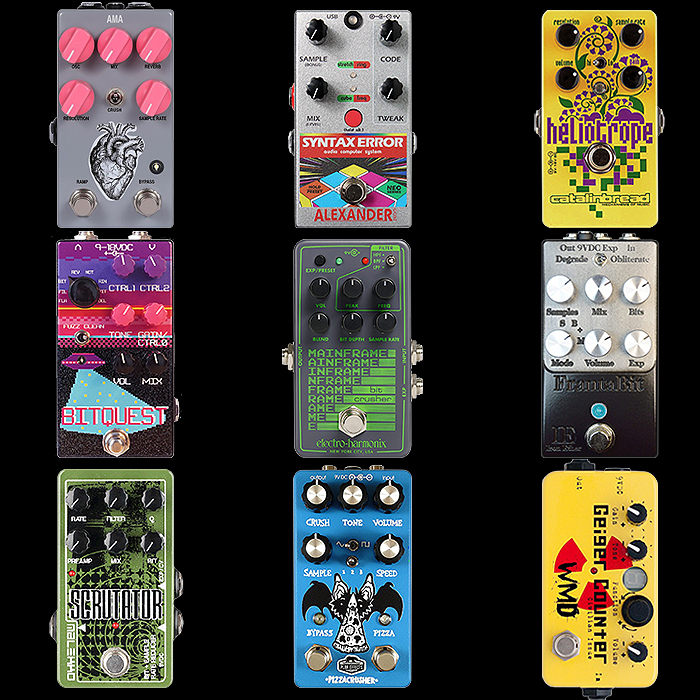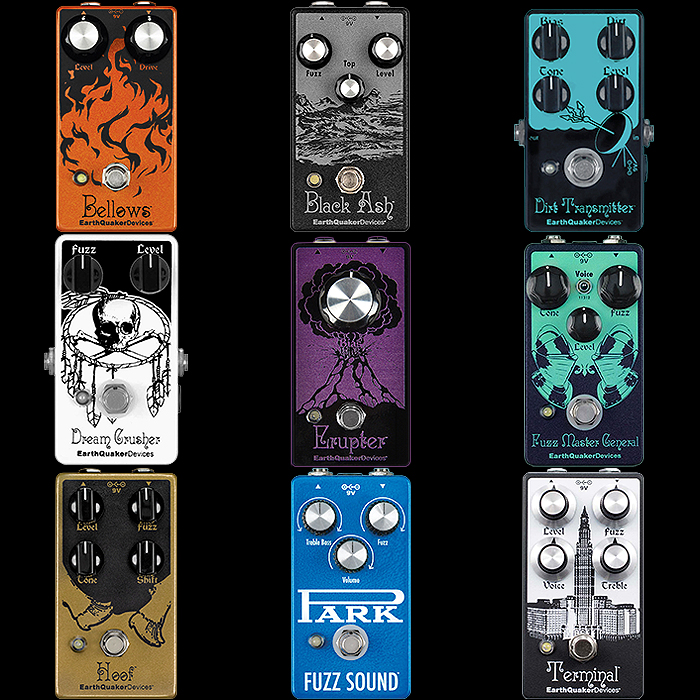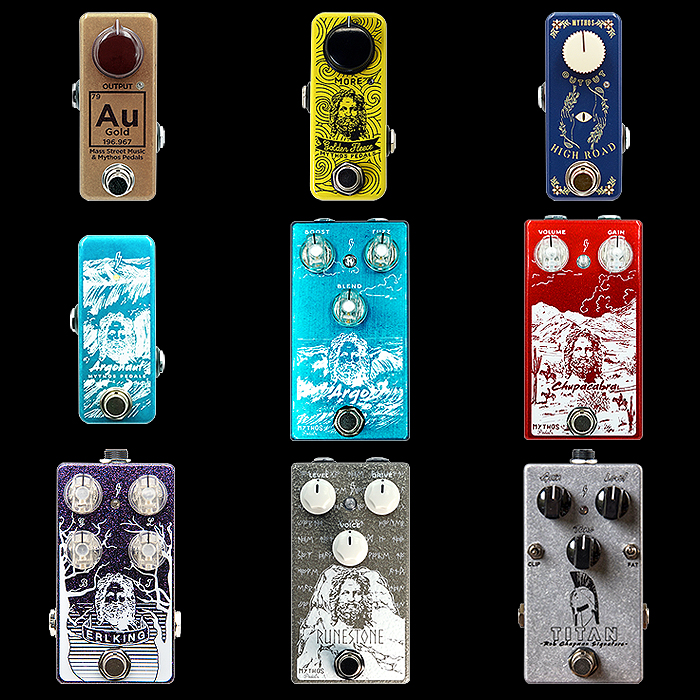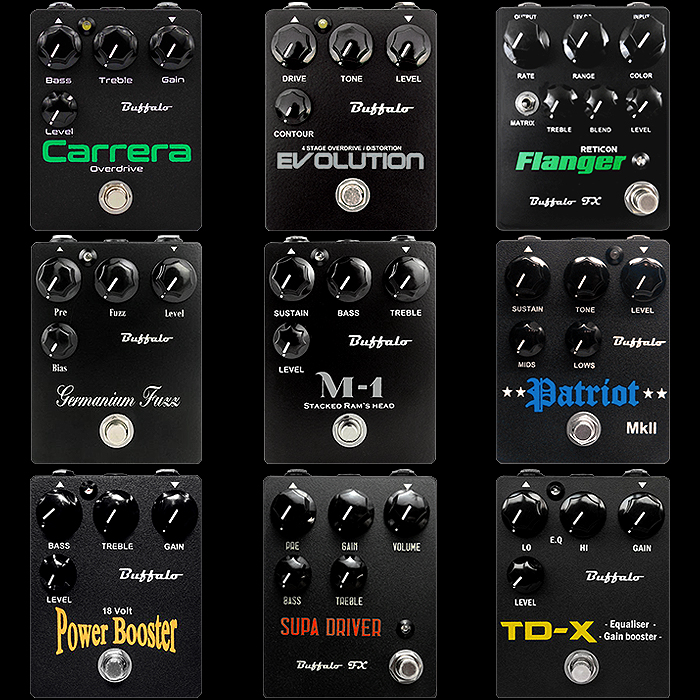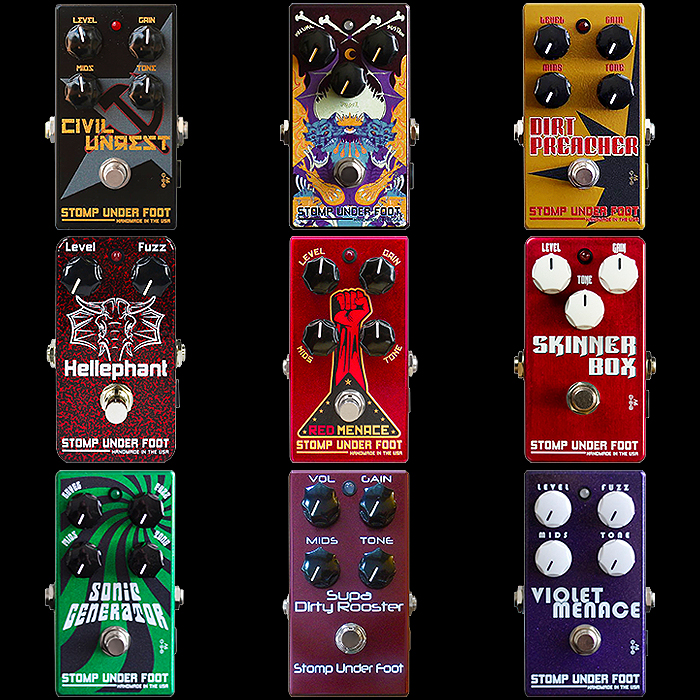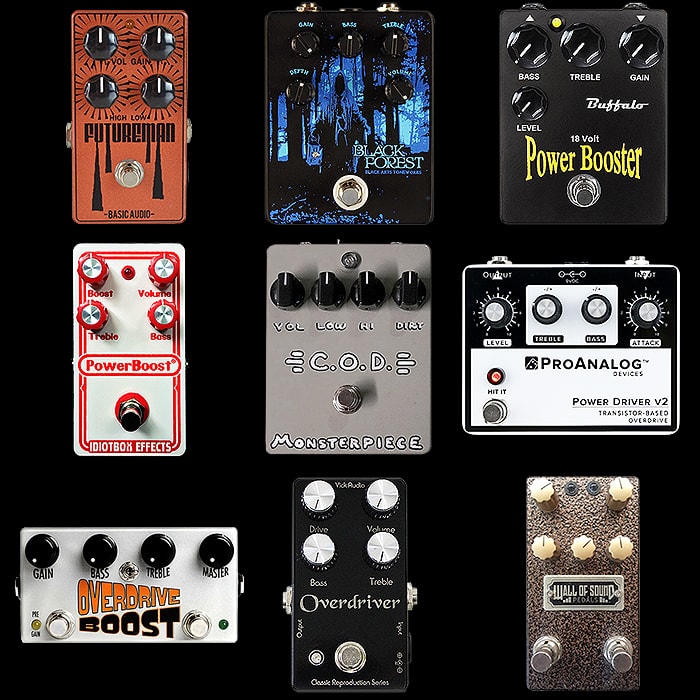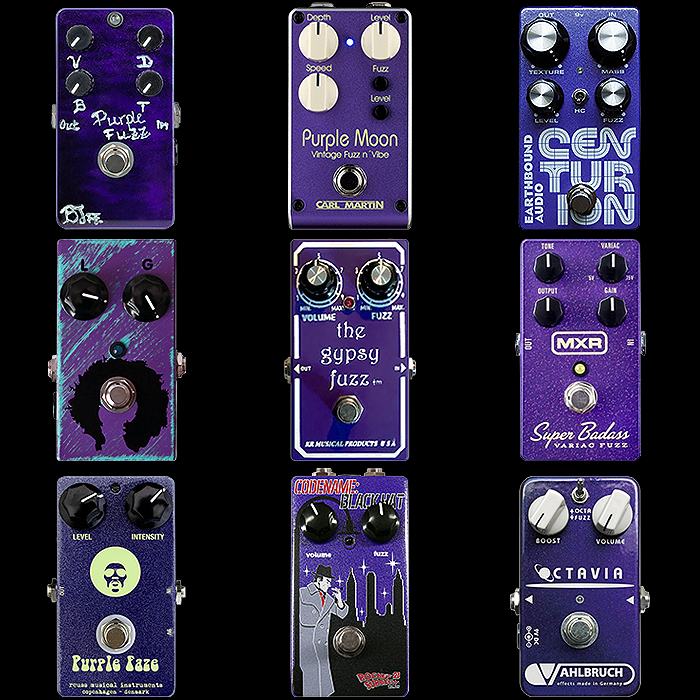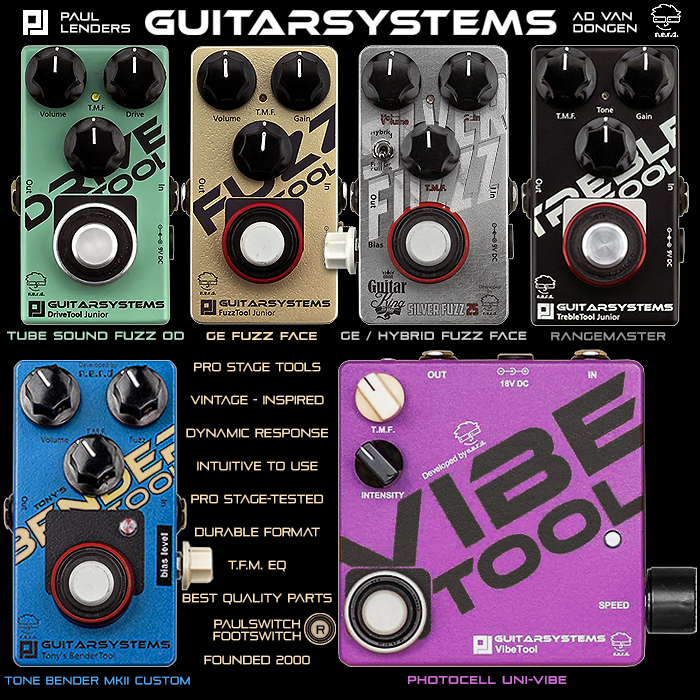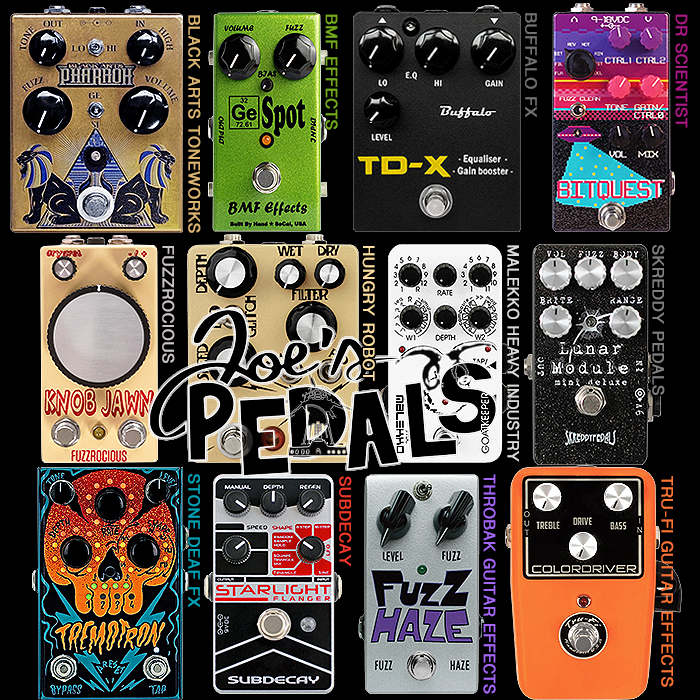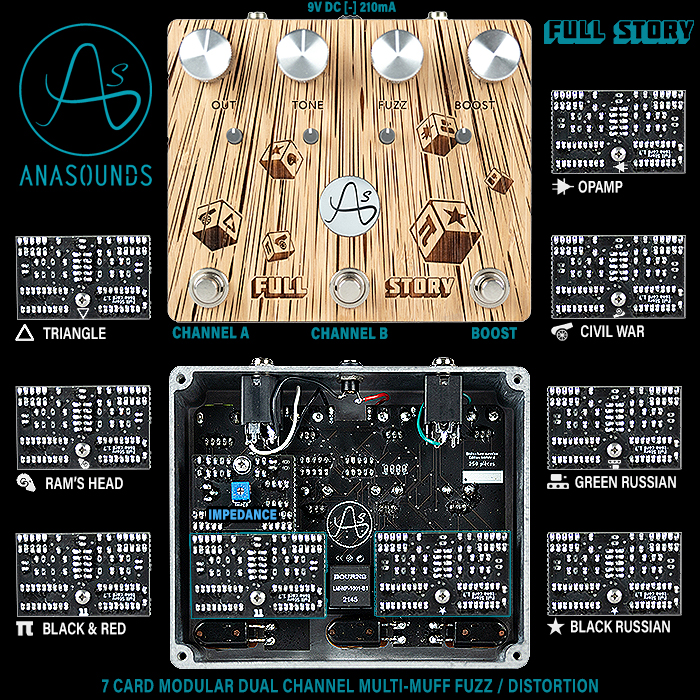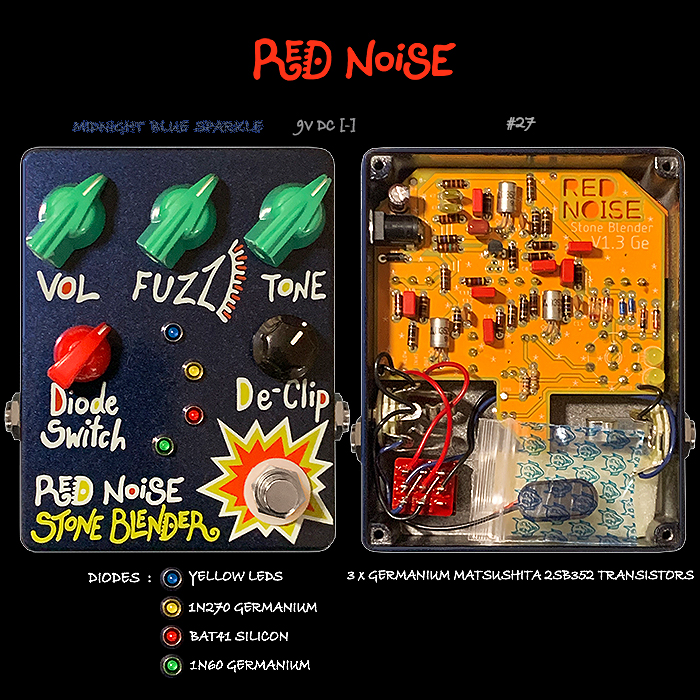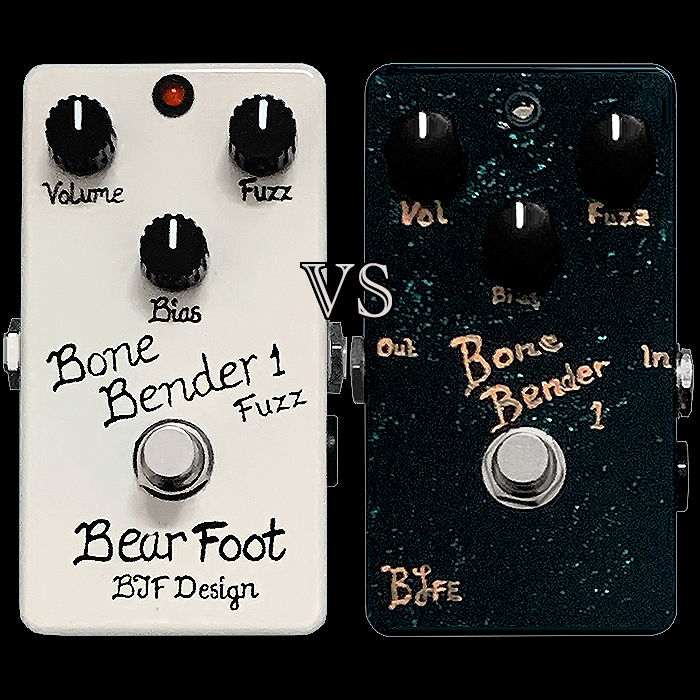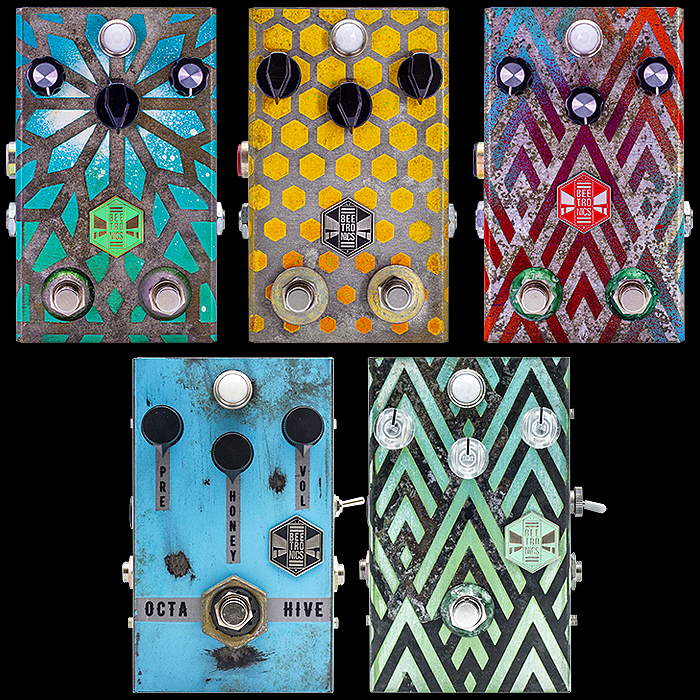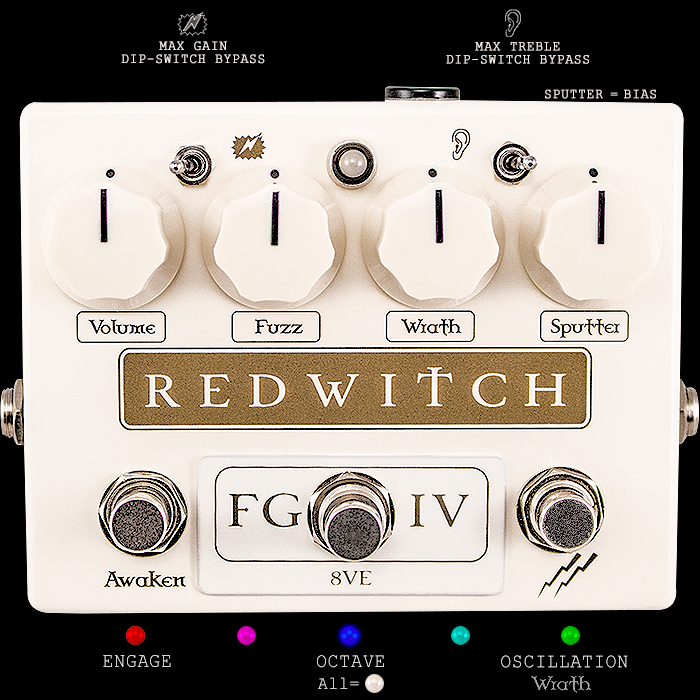4 Potent Matching Pairs of Vintage and Modern Style Compact Fuzz Pedal Duos
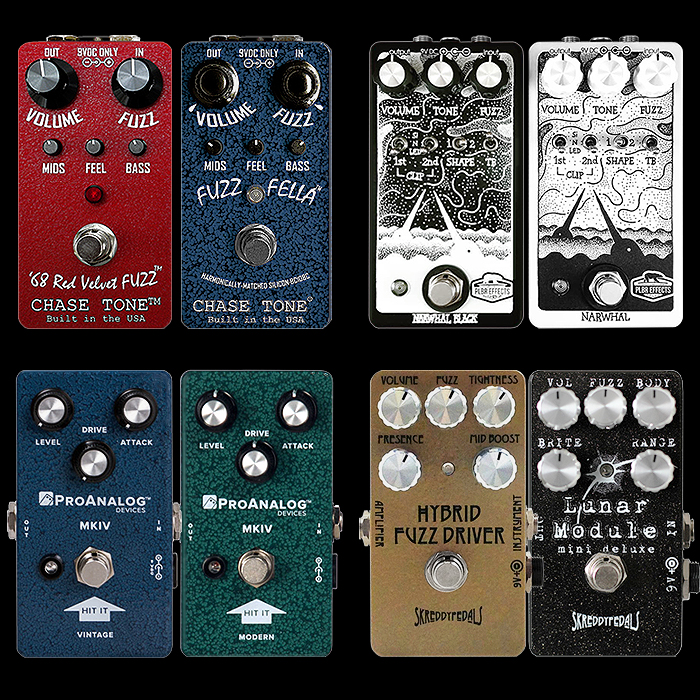
This post was suggested by a reader - a friend of the person whom I acquired the ProAnalog Devices MKIV Modern from near the tail-end of last year and via Reverb.com. Instead of covering just the ProAnalog pair though, I decided I should cover 4 matched sets of mine which have some underlying similarities in many ways. In each instance I had acquired just one of each of these pairs, but so liked that one pedal that I decided later to get the matching pair. The largest gap in pair completion was circa 2 years - which is not that long really.
These pedals have variously 2, 3 or 4 transistors, which are either all Silicon or a Silicon/Germanium mix. The essential ’Vintage’ character tends to be warmer, smoother, richer, creamier and more sustaining, with often a little extra in the lower frequencies. While the ’Modern’ character is typically more aggressive / strident / wiry with a more cutting edge / bite to it, often more of a mids-push, and generally slightly thinner in feel.
In all cases here this can be attributed to a large degrees as I will discuss in more detail for each individual pairing - to there being shared / common transistors used, so understandably some of the core tonality and sound of the pairs can be similar - while at other times it’s more distinct and disparate where additional component use and controls even can be more diverse.
When fuzzes only consist of Germanium transistors you can get a certain signature grittiness to the tone - along with the extra warmth etc., while when paired in hybrid fashion with Silicon you typically get a smoother, creamier and more sustaining tone. That Germanium warmth is still intact, but the core character can be quite different.
In transistors taxonomy, the BC183 Silicon transistor is typically the closest in feel to a Germanium type transistor - which is why BC183 style Fuzz Faces are so pervasive in trying to replicate that quintessential Germanium tone, but without the need for constant re-biasing. Kyle Chase of Chase Tone has made a career of designing Germanium-esque circuits using BC183 transistors, and the ’68 Red Velvet is one of the finest examples of that type.
Obviously the Chase Tone pedals here are Fuzz Face varieties, there are some similarities in the ProAnalog and Skreddy Pedals - which while 3 transistor circuits are really not Tone Benders, but have some of those qualities - I would place them both as Fuzzy-Drives, which is one of my favourite categories. The PLBR Effects duo is obviously a Muff variety - but with the different options - Multi-Muff rather than a specific variety, while the Vintage one is slightly closer to Triangle styles, and the Modern one rather veers more towards Ram’s Head - but the options available mean you can dial in a pretty extensive range of tones.
The pairs are listed alphabetically by brand :
Chase Tone '68 Red Velvet BC183 Silicon Fuzz - discontinued - Vintage Style - $170 when new
Chase Tone Fuzz Fella BC108C 70's Silicon Fuzz - Modern Style - $135
This harks back to my 6 Potent Pairings Fuzz Face Style Roundup - while there we focused on various Germanium varieties versus BC183 Silicon types. Here you have the classic Vintage and Modern pairing even down to the Dallas Arbiter style Red and Blue colour selection. The Red Velvet obviously being modelled after the original Germanium variety, and the Blue Fuzz Fella after the latter Silicon variety - in fact a classic contrast with the more aggressive BC108C transistors. These are both wonderfully nuanced fuzzes - and the fact that you have those extra dials - Mids, Feel and Bass gives you incredible tone-shaping potential. Feel is essentially Bias, and you can dial up or out both Mid and Low frequencies - these are really cool extended range Fuzz Faces. I actually really like both varieties - generally I'm a sort of Germanium guy, but every now and again I want the more cutting/biting edge of the spectrum - which means those more aggressive / strident Silicon transistors. These are both great fuzzes - but if I only had to have one - it would be the Red Velvet.
PLBR Effects Narwhal Black Vintage Silicon Muff Style Fuzz (4 x 2N5088) - discontinued - €114 when new
PLBR Effects Narwhal White Modern Silicon Muff Style Fuzz (4 x 2N5089B) - discontinued - €114 when new
I'm a big fan of Darko Vajda's Polarbear Effects Pedals and have 4 in the collection to date. I have also negotiated for a copy of the now discontinued Floral Green Multi-Screamer, but since he's busy working on the Young Hearts Lo-Fi Delay these days - I'm leaving him alone to get those orders out. He has made 3 fantastic Big Muff style pedals to date, and I had the #8 of the White Narwhal type - which arrived a good year and a bit before the Black edition. Because of the innate similarity and simple inversion of the artwork I originally took the Black version just to be a different colourway. The Black Narwhal though is the more Vintage inspired variety of Big Muff - leaning closer to the Triangle Style - with that lovely well-balanced frequency curve and slightly more lows in the profile. Compared to the slightly tighter sounding and more mid-pushed core tonality of the White Modern variety which is much more Ram's Head in nature. You get a whole series of extra toggles for further tone-shaping beyond the classic Volume, Tone and Fuzz knobs. For both gain stages you can select Silicon/None/LED clipping, and then you have a sort of EQ Profile / Shape Shift which generally gives you more or less mids. You also have a Tone Bypass switch which removes that shaping from the circuit and essentially gives you a little boost too. This is one example where I really struggle on the 'if you only had to have one' question - as I really like both here pretty much equally. The White Modern version was out first and I really got used to using that, and then the Black edition arrived with more of that sort of Triangle warmth to it. Generally my favourite Muff variety is Triangle type, while I really like Ram's Heads too - and probably have equal numbers of both of those in the collection. It's just too close to call here - both of these are really great.
ProAnalog Devices MKIV Vintage Hybrid Fuzz (2 x BC237B + CV7112) - $299
ProAnalog Devices MKIV Modern Silicon Fuzz (3 x BC237B) - $199
There's actually quite a few similarities between the ProAnalog and Skreddy pairs - they both have a sort of typical 3-transistor Tone Bender style makeup, but circuit-wise are really quite different from that sound, and while the ProAnalog ones have a little of that MKIII/MKIV character in them, the Skreddy ones really don't. The Vintage MKIV was the very first of all these pedals that I acquired, and has probably been the one most in circulation on my pedal-chain for one reason or another. It has a lovely creamy, saturated and sustaining character - and can be dialled up to fuzz territory or down to a sort of Germanium overdrive sounding profile - those three knobs are actually all very interactive and have a lot more combined range that you would necessarily credit. ProAnalog describe the Attack parameter as the amount of Fuzz, while the Drive lets you dial in the amount of transistor-based overdrive. My preferred setting for the Vintage is Attack at 3 o'c and Drive at 12 o'c, while for the Modern I prefer the Drive fully maxed - Attack at 3 o'c also. Similar to the Skreddy pair these obviously significantly share the same transistors and there is a degree of overlap with the pedals where you can dial them in similarly. For the most part though the Blue Vintage one is smoother, creamier and richer sounding and would for sure be my choice if I could only have one. There are however times when I want the slightly more attacking / more aggressive Modern version - which I would actually probably have preferred to have been a little more aggressive in character and rather more distinct form the Vintage. As it is they definitely have a common sound signature right at the core of the tone - you just need to decide how smooth and creamy or cutting you like your fuzz / drive to sound!
Skreddy Pedals Hybrid Fuzz Driver Germanium+Silicon Fuzz/Drive (2 x BC109C + AC127) - $249
Skreddy Pedals Lunar Module Mini Deluxe Silicon Fuzz/Drive (3 x BC109C) - $249
My understanding used to be that the Lunar Module existed first, and Marc Ahlfs later introduced the Hybrid Fuzz Driver as a more Humbucker-friendly version of the Lunar Module circuit. Like the ProAnalog devices pedals these are triple transistor circuits - with one being all BC109C's, while the other swaps out one of those for an AC127. Much the same paradigm exists for the Skreddy pair like the aforementioned ProAnalog one - in that the Hybrid Fuzz Driver is creamier and smoother and generally less attacking than the Lunar Module - also has more low-end. I see these both actually as sort of David Gilmourish sounding pedals - while supposedly only the Lunar Module is specifically based on a Gilmour tone - namely the guitar solo from the 1973 'Time' song. Marc describes the HFD as being based on Jimmy Page's Marshall 1959 Super Lead tone, but I don't really get that exactly - my favourite pedal for that is the Xotic Effects SL Drive. I see the Hybrid Fuzz Driver as very much a creamier smoother pair to the Lunar Module - which is in turn more attacking and cutting in nature. You can dial them in fairly similarly if you dime the 'Tightness' control of the HFD - while in this instance the pair don't have as similar a tonal characteristic as the ProAnalog set above. Obviously there are more component differences - alongside slightly different controls. The HDF has Volume, Fuzz, Tightness (Lower Mids), Presence and Mid Boost, while the Lunar Module has Volume, Fuzz, Body (Bass), Brite, and Range (Transistor Input Gain). I really like each of these in their own way and you can dial the two pedals in to sound very different, so it's difficult for me to pick an overall favourite here - I really like both!
Final Thoughts
You will surely have gathered by now that I'm a little OCD on these kinds of matters, and more often than not obsessed with symmetry and a sense of completion - meaning I'm often tempted to complete a pair of particular pedals. I usually buy my preferred version first, and then get the second one significantly later on - often as a second hand pristine version or a special offer. I still have quite a few pairs as such to complete - which are typically lesser priority. I usually just bide my time and wait for something to appear in my extensive Reverb.com feeds - if the timing and the price is right I will more often than not go for it, while sometimes I'm really just not in the mood, or otherwise committed. So it's by no means a foregone conclusion that if I have one I will automatically have the other - I really do have a quite significant number of those unattached pairs to complete - but generally I don't loose sleep over it.
Of all of the above and as mentioned - the ProAnalog MKIV Vintage has been most in rotation, followed by the Red Velvet and Hybrid Fuzz Driver probably. I think generally my own taste leans toward Germanium / Hybrids / Vintage styles - while I do very much on occasion like an all out attacking / aggressive Silicon fuzz. There's quite a significant price range here, and at least half of these are out of production currently. I actually prefer my older style ProAnalog MKIV's to the newer editions - while it doesn't look like Scotty is making any more of the Modern Green variety. I'm not sure why the Red Velvet is now discontinued, or the two Narwhal's - while I know that Darko gets easily boored in building the same circuit over and over and really prefers to move onto something new - like his current Young Hearts Lo-Fi Delay, and forthcoming Drowner Multi/Combination Drone/Shoegaze Effect.
Which of these above you are likely to have a preference for depends very much on whether you like things slightly rougher or smoother - where the tonal profile sits exactly - what the proportion of highs to mids to lows there is at the core etc. It's very difficult to pick out any one pedal here or single pedal pair really - while it's pretty cool just how versatile the ProAnalog duo are with just their 3 dials. For simplicity's sake possibly the MKIV Vintage is the overall single recommendation, but all of these pedals really have hidden depths and each can and does sound amazing. I think I've said pretty much all I can on this subject now - I've laid out the commonalities and differences - by all means do some of our own triangulation and due-diligence, and make sure you listen to a variety of YouTube demos - before you make your choices...








